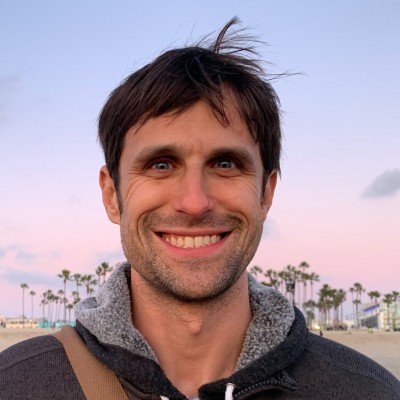What do you make time for?
Last year, I made time for the things I care about most — creativity, writing, music, growth, and meaningful progress on a new app.
Here’s where my time went:
- 🎶 Music: ~314 hrs - This time shows consistent focus on my creative goals including releasing two new albums as well as expanding with collaboration and refining my production skills.
- 🚀 Stay Reflective: ~280 hrs - My startup app received a significant time investment, resulting in a few product milestones, a successful pilot, and growth experiments.
- ✍️ Writing: ~139 hrs - While this fell short of my ideal, the writing helped me find clarity and enabled me to share content on AI, creativity and data.
Was this enough time for my desired outcomes? Are adjustments in order for year ahead for making more time for what I care about? If so, how?
Where was most of my time spent?
When I look at where I actually spent my time, here’s what it looks like:
- 🛌 Sleep: 7.55 hrs per night
- 💻 Computer Time: 6.43 hrs per day
- 💼 Professional Work: 3.57 hrs per weekday
- 📱 Phone/Tablet Time: 2.16 hrs per day
- 🏃 Exercise: 1.08 hrs per day
I feel good about my consistent sleep and exercise routines, but my device time, particularly on my phone and tablet, feels higher than I’d like. While half of this time is positive (e.g., reading and educational videos), the other half often goes to distractions like Netflix and YouTube.
Road Ahead: Figure Out What You Want to Make Time For
Time management is a cornerstone of life, but it’s not just about how you spend your time. It’s about what you make time for.
In the past, I fell into the “efficiency trap,” chasing productivity hacks that saved minutes but consumed days of effort. I learned that productivity alone won’t bring fulfillment nor solve all of life’s changes. You eventually hit a wall, because the more productive you become the more demands are placed on you (either by yourself or by others).
You can’t out-hustle your limitations or mortality.
Instead, I believe in two key steps:
- Figure Out What You Care About. Explore what truly matters — your passions, projects, and people. Journaling and reflection are invaluable here.
- Align Intentions with Time-Bound Actions. Prioritize and commit to what matters most. Progress takes time, but the key is showing up consistently.
💡 If you’re ready to align your time with your values, Stay Reflective offers guided reflection journeys to help you get started. It’s got lots of reflection starters and each exercise comes with dynamic and personalized follow-up questions.
In this post, I want to share my latest year-in-time data visualizations, analysis and a public self-reflection. I have spent years developing habits and technical skills centered on time tracking various aspects of my life. While I wouldn’t recommend immediately tracking everything in your life, hopefully you can see how time tracking and data help me illuminate the broad lines of my days, weeks and months and enable me to find opportunities, overcome challenges and pursue actions towards the goals and activities I personally care most about.
Let’s jump into my time data.
A Year-in-Time: My Key Time Indicators (KTIs)
Where did my days and time go in 2024?
The short answer is a lot of my days was spent on my computer and/or on my projects. Nearly 92% of days in 2024 I used my computer (335 total computer days), and about 89% of days I manually logged “project” time.
I put in 1,854.2 total project hours, meaning I was active and cognitively engaged working on something. Often this was either professional work or creative projects (writing, music or my startup app). We will look at my project time in greater detail in a separate section below, but overall this alignment of computer time with project time is a good indicator of using my time meaningfully. The challenging and more difficult to answer question is whether or not I spent my time “right” or I made enough time for the outcomes and goals I had and have?
Let’s look at my time data more, before returning to these intentionality-behavior alignment questions.
Here are a few of my key time indictors (KTIs) from the last year:
My Total Screen Time: 2346 hours
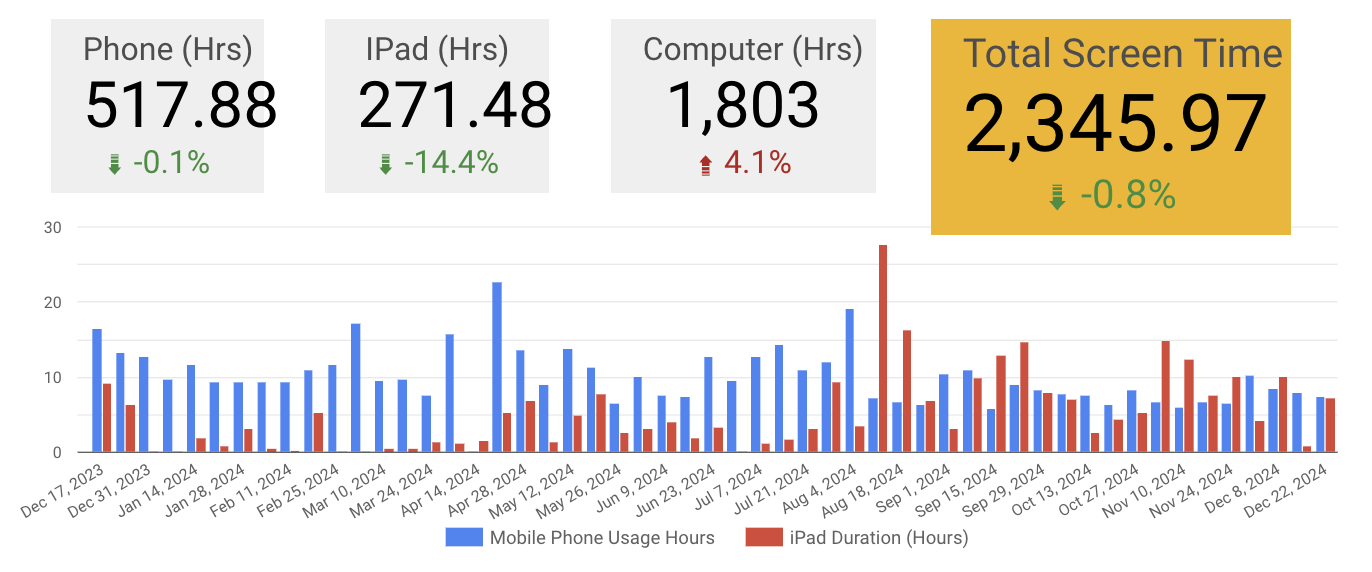
What was my screentime last year?
- TOTAL SCREENTIME: 2346 hours.
- COMPUTER USAGE: 1892.4 hours.
- PHONE TIME: 517.88 hours.
- TABLET TIME: 271.48 hours.
That averages out to about 6 hours and 25 minutes of tracked screen time per day.
From a screentime tracking perspective, I have a nearly complete picture of my screentime, meaning how much time I spend on my core devices. I track my screentime using RescueTime (computer) and log my iPhone and Tablet time every week or two manually during my data-driven weekly review.
Let’s look at a few other slices of my time data, before comparing year-on-year and opportunities.
My Total Computer Time: 1892.4 hours
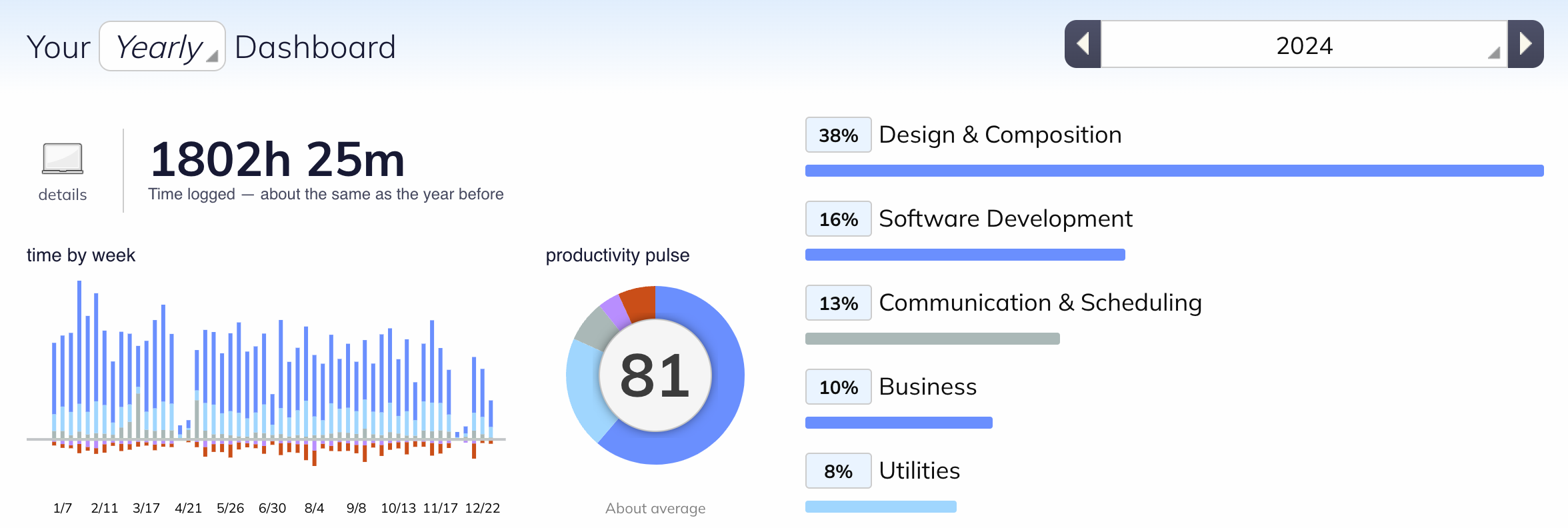


As a software developer and designer, I use my computer a lot. I track my computer time using Rescuetime, which gives me a lot of granularity of my time usage as well as some key yearly numbers. Here are some notable numbers:
- 335 total computer time days
- 30 computer free days
- 1,801.7 total computer hours
- Daily Average (of tracked days): 5.4 hrs
What programs and activites did I use the most?
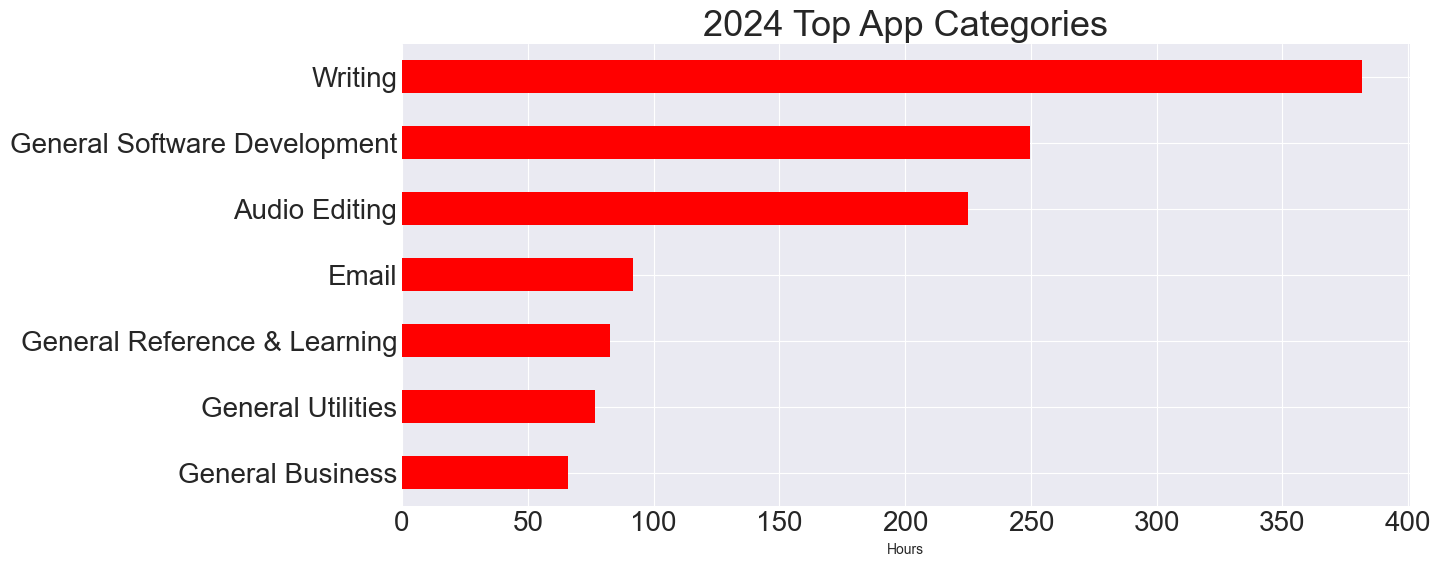
Here are my top tools used in 2024 with their yearly percentage change:
- Note-Taking & Writing Tools: 381.5 hrs (-2.5%)
- IDEs & Software Development: 249.7 hrs (-7.0%)
- Music Proudction & Audio Editing Tools (Ableton): 224.8 hrs (+20.4%)
- Email: 91.7 hrs (+1.0%)
- Reference & Learning Sites: 82.7 hrs (+8.4%)
- Utilities: 76.6 hrs (-4.3%)
- Business Stuff: 66.1 hrs
- Graphic Design: 49.4 hrs
- Video Production & Editing: 34.5 hrs
- General News & Opinion: 34.3 hrs
QUESTION: Does my time using these tool categories fit and align with my goals and creative and professional target outputs?
YouTube Time: 243h 28 minutes

Even though I do some learning and education on YouTube, I primarily use YouTube for entertainment. I watched about 4h and 40 minutes per week on YouTube. Unless there was some time tracking error, I spent a lot more time on YouTube in 2024 than 2023. In 2024, I spent 244.5 hours watching YouTube compared with 172.4 hours in 2023.
This continues a two-year trend increase compared to a low of just 143h in 2022. Admittedly, I did notice and note this spike in YouTube usage over the summer, and I have taken some action, like uninstalling YouTube from my phone.
QUESTION: What would it take to reduce my Youtube usage and/or become a bit more mindful and intentional about my usage?
Non-Device Time: Sleep, Exercise and Activity
As a healthtech software builder and head of product at a longevity research group, I am overdue for a data-driven review of my my efforts at de-aging and longevity tracking. My yearly Health and Fitness data merits a deeper dive and a separate blog post (coming soon).
For now, here are my top health time data points for 2024:
- SLEEP: 7 hours, 33 minutes per night - I track my sleep with a Oura ring. I saw a negligible 1.2% increase in my sleep compared to 2023. This is close to the recommended 7–9 hours for adults. QUESTIONS: Is this enough sleep? How might I increase my sleep time and quality? And how does it impact my cognitive abilities and aging?
- MOVEMENT & EXERCISE: 1 hour 5min daily - According to my apple watch, I got a decent hour of movement everyday. Over an hour a day is consistent with health recommendations and represents a a meaningful 27% improvement over 2023 (51 minutes daily).
- WORKOUTS: 135 hours of logged workouts (~2.6 hours per week) - Using Strava, I logged workouts 172 days in 2024 (~47% of the year) shows that I have strong and consistent exercise habit. My workouts mostly included running, cycling, and pickleball. I did very little weight training (less than 5 hours for the year). QUESTIONS: Have my change in exercise routines translated to lower or similar fitness levels? How might increased or varied workouts impact key fitness and health metrics?
Trends Across Time: Weekly Changes in Time Usage
By combining all of my time related data I get to see a week-on-week chart, broken down into categories such as Health and Fitness, Tablet, Phone, Computer Usage, and Sleep like this:
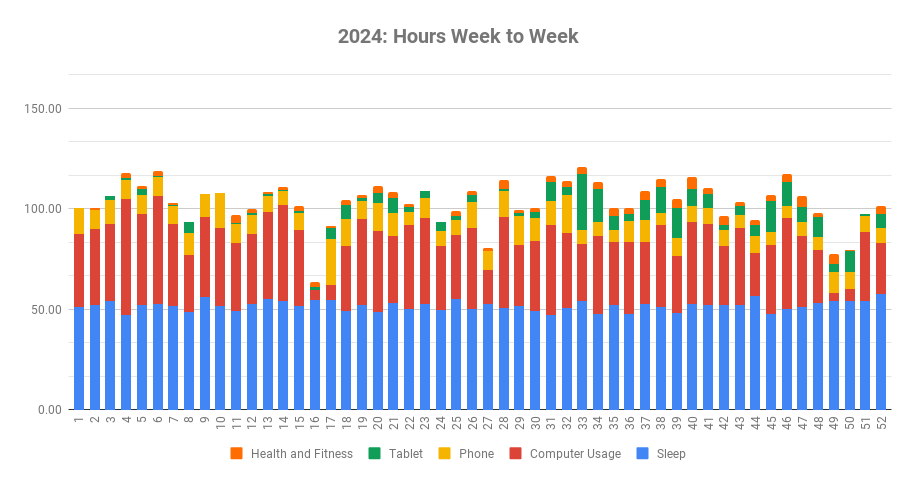
Looking at the chart, here are some key insights:
- 🛌 Consistency in Sleep - My sleep patterns (blue bars) appear to be relatively consistent week-to-week, at least when seen in terms of weekly sleep averages. This suggests a stable sleep routine, though I should look at this with greater grandularity and potentially consider my readiness and activity level as well.
- 💻 Highly Variable Computer Usage: My computer usage (red bars) appears to be he largest and most variable category week-to-week. Are lower periods associated with time off, sickness or something else? Do weeks showing significant spikes correspond to periods of intense focus on work or creative projects?
- 📱 Relatively Small Yet Stable Tablet and Phone Screentime - I have aspired to limit my non-computer screentime for a number of years including a 30-day youtube detox a few years ago. It’s good to see that my phone usage (green bars) and tablet time (yellow) are relatively small and steady. I uninstall YouTube and don’t use social media apps on my phone. Generally my phone usage involves navigation, communication (email, messaging), music listening, and quick tasks.
- 🏋 Health and Fitness Patterns - A quick review of my health and fitness (orange bars) show noticible fluctations. Do these correspond to shifts in your workout routine or periods of lower activity (e.g., busy work weeks or travel)?
- ⚖️ Balanced Time Allocation: Viewed at a high level, I see a consistent, healthy and balanced time usage across different activities. Excluding computer usage, no single category dominated my weekly hours in 2024.
Comparing Years: 2023 vs. 2024
How does this year compare with past ones?
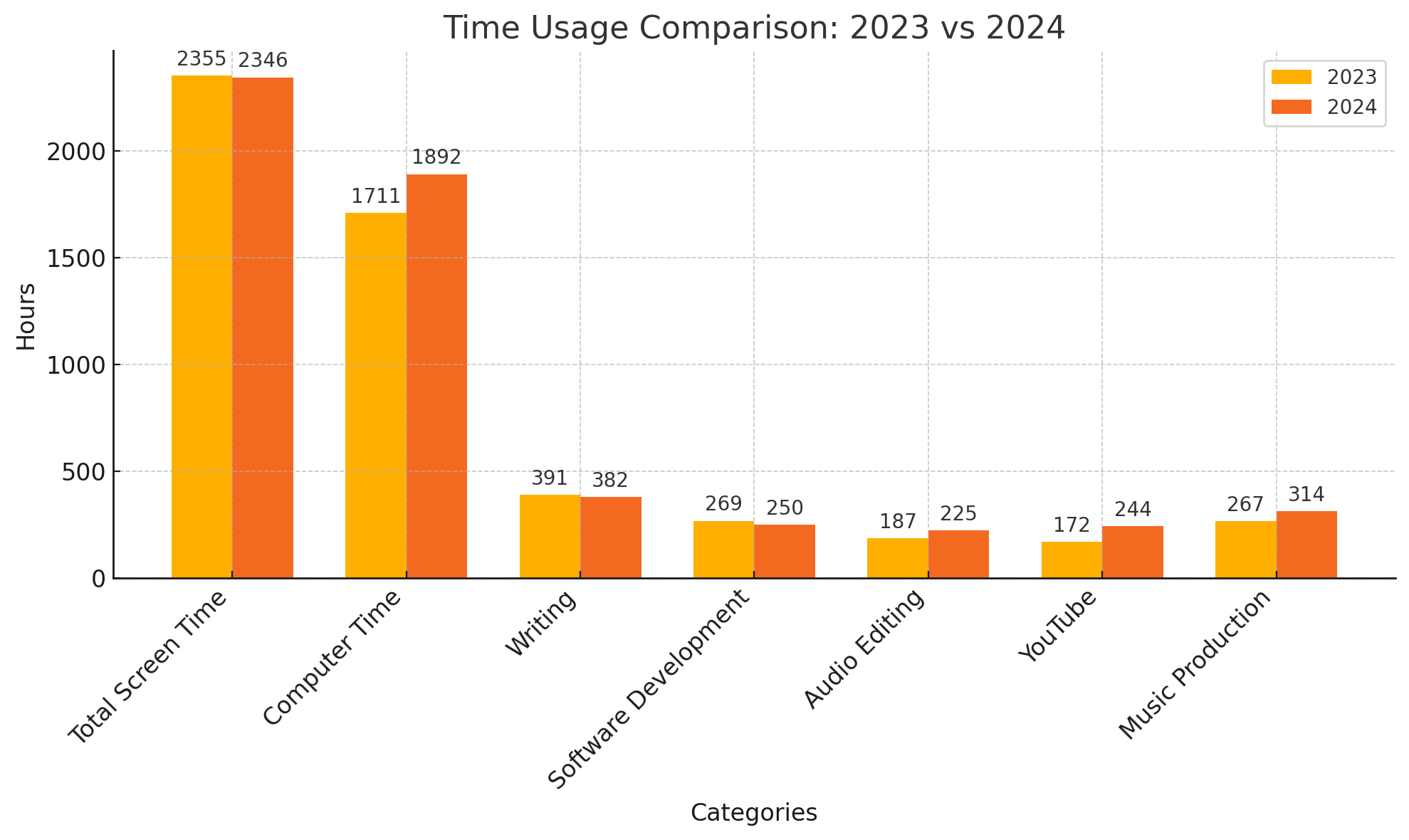
In total, I recorded about 2,346 hours of screentime in 2024, which is nearly identical to my 2023 numbers (2,355 hours). Interestingly, I increased my computer time from 1,711.2 hours in 2023 to 1,892.4 hours in 2024. This translates to less time on my phone and tablet, and it likely indicates an improvement in more focused, cognitively engaged time, rather than passive consumption and media habits.
Cognitively-Engaged Project Time
While I can passively track my computer time with RescueTime and get good screentime usage data on my phone and tablet, I get the most benefit and my most insightful time dataset by manually tracking my project time. Specifically, I use a manual time tracker tool called Toggl to log all of my work hours, creative time and various admin tasks. Each task includes the project I’m working on and a brief note or gist of the activity. Pulling this data together and doing some data visualization quickly reveals changes over time and trends on what I am spending my time on.
My Project Time: 1,854.2 total project hours


Excluding two weeks in late April (travels in Japan), two weeks in early December (travels in Belize and Honduras) and end of year, my project time was pretty consistent and evenly distributed across the year and day to day. We see a strong weekday time allotment too. I see a noticable dip in project time on Saturdays and Sundays.
The “Big Picture” of My Project Time
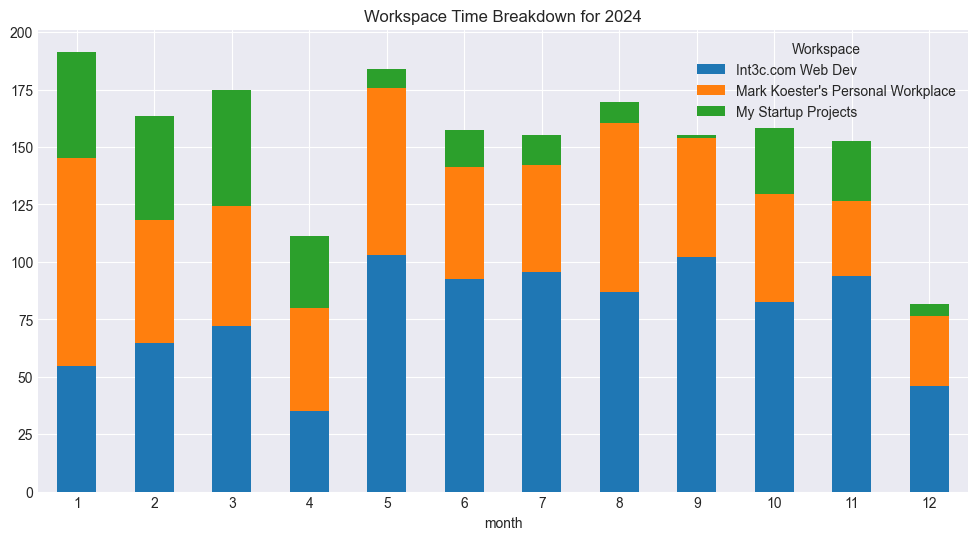
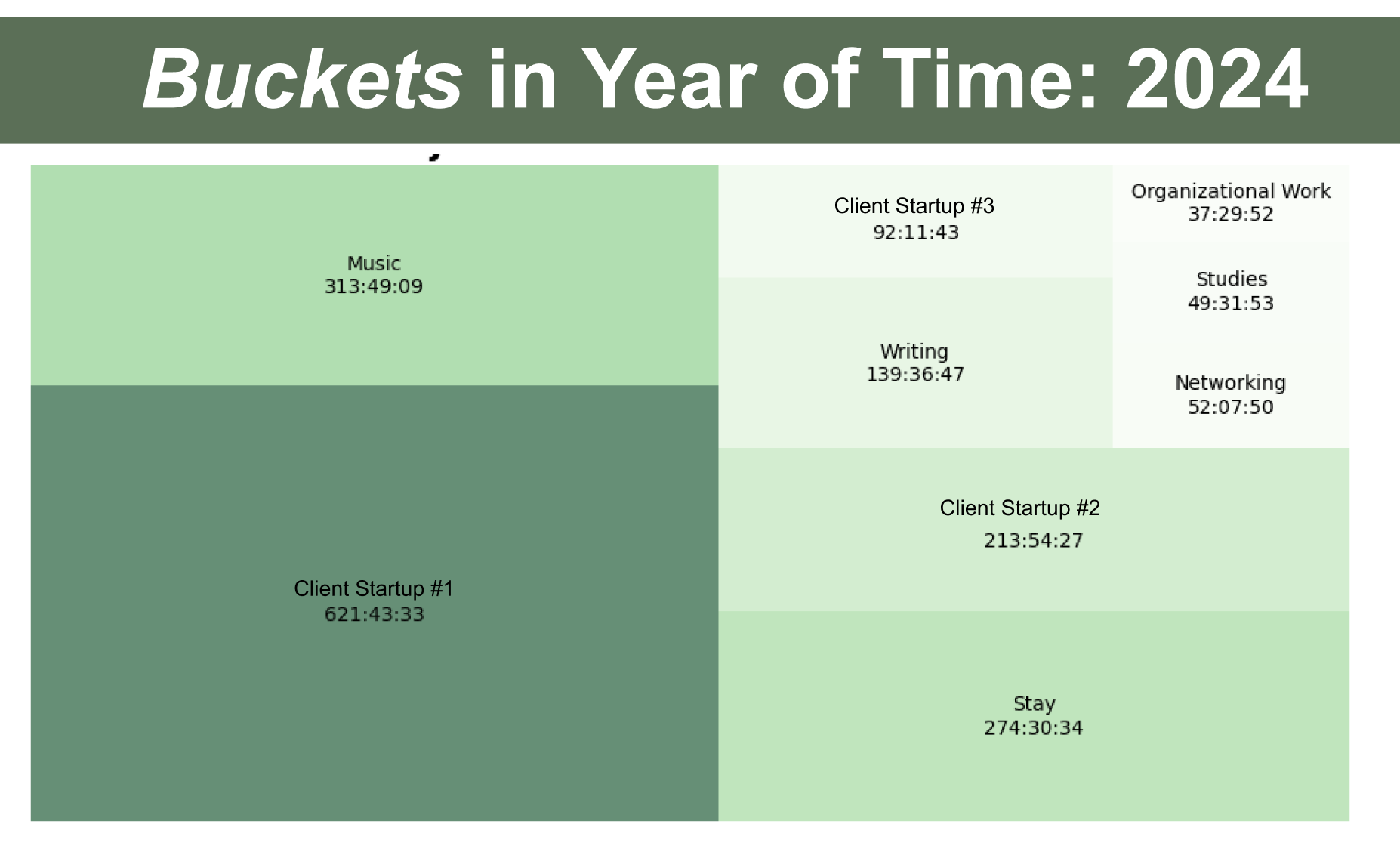
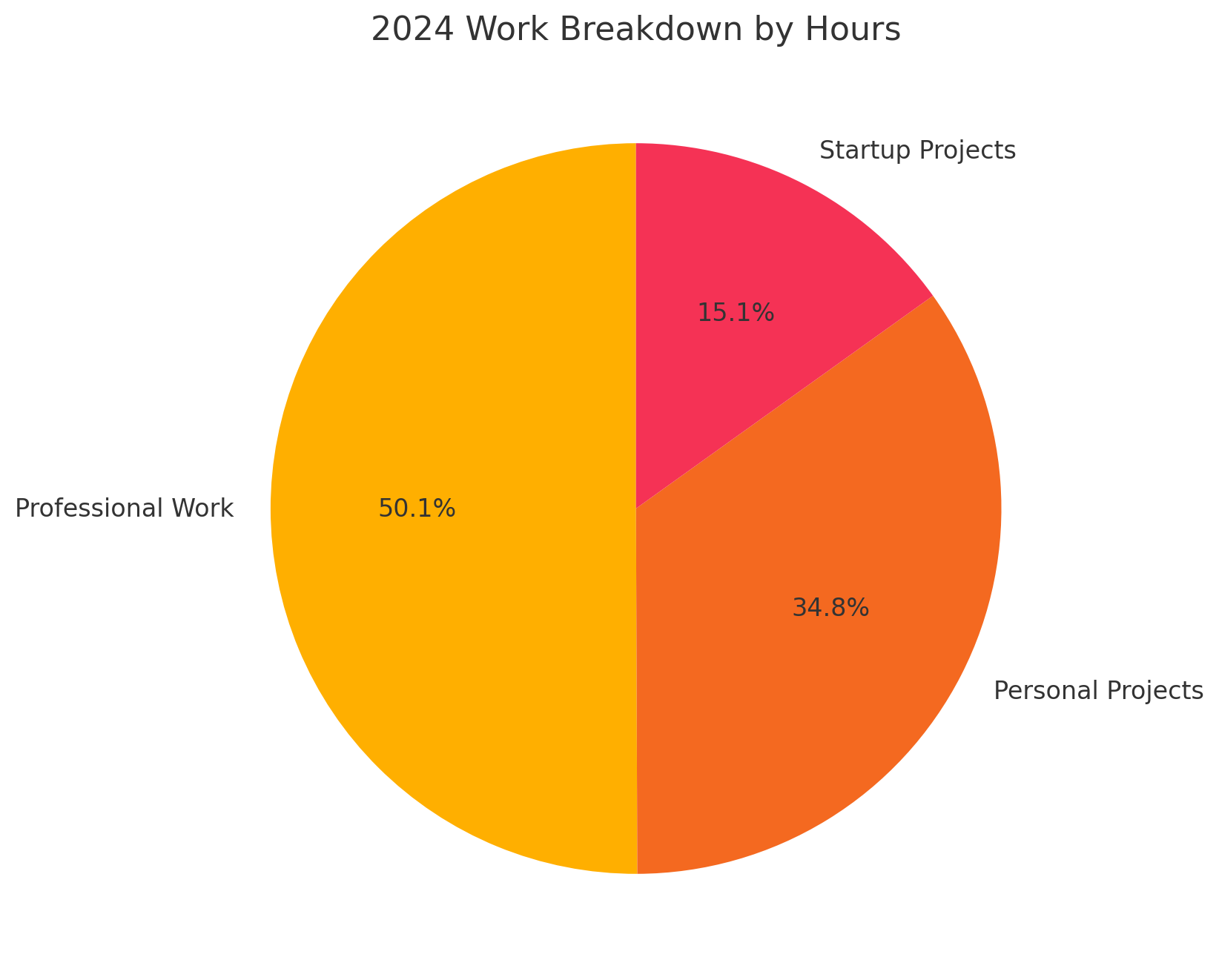
Here are the exact numbers:
- Professional Work: 928.34 hrs (50.06%)
- Personal Projects: 646.08 hrs (34.84%)
- Startup Projects: 280.09 hrs (15.10%)
Professional Work: 928.34 hrs


Like most working professionals, the majority of my time goes to professional work and my clients. I dedicate roughly 19 full hours per week in my case. While I formally log my hours for my personal time analysis, the reality is that I also often spend an additional 20% or more of time thinking and talking about my professional as well as various unlogged calls, logistics, planning, note-taking, research, etc.
Personal Projects: 646.1 hrs


About 12.4 hours per week goes to my personal project time. This category covers several areas. Here is a breakdown of some of my key non-professional work:
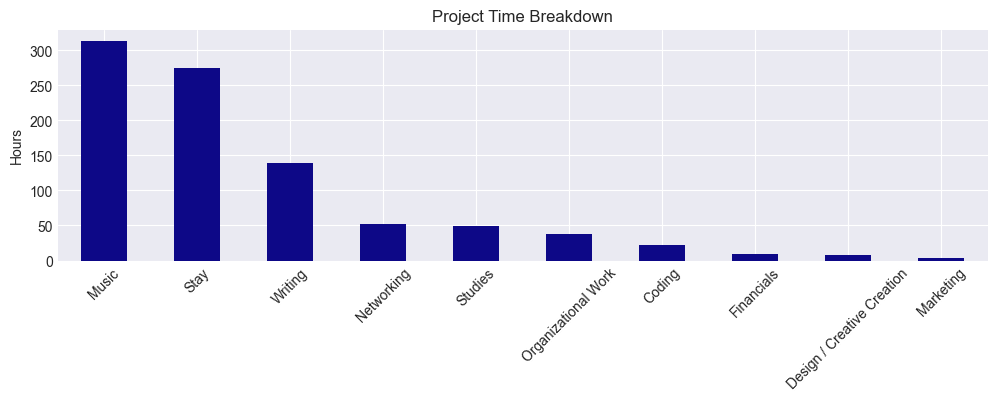
Creative Projects: Music, Writing, App Development
🎶🖌🎨 Read my separate write-up and analysis: 2024: Year in Creativity [Coming Soon]👀
As I mentioned in the intro, my personal time and creative projects are fundamental to my life, and I make time for them. I hold a deep commitment to self-expression, personal growth, and creative output. I value reflection, journaling and note-taking. And I am a life-long learning, both in terms of yearly book reading and in terms of always-be-studying, skill-building and staying curious.
Let’s dig into how my time data reflects these goals and values:
🎶 Music Making & Music Production: 313.8 hrs


My main creative hobby currently is music making and music production. I currently release my music under the artist name of Stellar Mammals and primarily personally produce and release instrumental focus music.
Along with regular exercise, music helps me relax and ground me. It’s a constant source of joy, fun and inspiration. It’s something I really enjoy, though I wouldn’t necessarily define myself first and foremost as a musician. Music making puts me in a state of flow, and collaborating with others around music is my one of my main social activities too.
Overall, I spent ~314 hours in 2024 on my music, marking a significant focus and increase from 2023 (267 hours). It was really fun to jam, explore a bunch new musical directions, and create new demos and songs. According to RescueTime, this included ~225 hours total on audio editing tools like Ableton Live.
I averaged 26.15 hours per month on music. My lowest amount of music time was April, when I had a hard professional work push and personal travels in Japan. My two biggest months were May and August, which were most closely associated with original song writing and reworking for my fifth album.
The biggest shift in my music time was the dramatic increase in collaboration time. In 2024, over 100 hours was spent on music collaboration, compared with just 21 hours in 2023. For example, I worked with another producer reworking both albums and collaborated with a trumpeter, keyboardist and a few guitar players. Here is what that collaboration time allotment looked like:

In terms of my time input, here were my biggest music-related activites:
- Individual Re-working / Finishing: 74.5 hrs (23.7%)
- Collab Jamming & Song Writing: 63.6 hrs (20.2%)
- Individual Jamming & Song Writing: 42 hrs (13.3%)
- Collab Reworking, Re-recording and revisions: 31.5 hrs
I had an additional grab-bag of individual music related activites that totalled 95.6 hours, reflecting a mix of creative, reflective, and organizational efforts. For example, I spent 5h on album art and releasing and 2.6h on finishing and mastering. I also put in an additional 2.3h on music reflection (e.g. reviewing and reflecting on the album or music direction, evaluating progress or setting future goals).
In terms of tangible outputs, I produced and released 26 tracks and two new albums:
- Stardust and Dreams - 15 tracks
- Chop Wood, Carry Water - 11 tracks
I also made significant progress on my next album as well as a host of new tracks with vocals and in new experimental genres. Unfortunately, while I did grow my music listenership and following somewhat this year, especially on Spotify, I didn’t make as much progress on music production or music videos. Along with doubling down on collaboration and balancing new song writing with reworking and finishing, I’d love to expand my music videos work in the year ahead, ideally with more collaborators!
✍️ Creative Writing: 139.4 hrs


Writing allows me to explore intellectual interests, externalize my learnings, share my work projects and experiments, and engage in meaningful self-reflection. Historically writing has been number primary creative hobby and outlet. I’ve written hundreds of blog posts and delivered dozens of research-backed talks and papers.
For a range of reasons my writing time has steadily declined over the years. Unfortunately this trend continued. Last year in 2024, I spent 139.4 hrs writing, compared with 208.2 hours in 2023. This representes a roughly 33% decrease and was a significant reduction.
Interestingly I did manage to journal, reflect and review regularly. Specifically, I spent 59.6 hrs on journaling, reviewing and general reflection. One of the interesting benefits of building my reflection-empowering app, Stay Reflective, is the ability to help myself and others journal more regularly and get into deeper moments of introspection.
For example, whenever I’m struggling on my goals or next steps, I often start by jotting some initial thoughts and notes. By then using one of the reflection journey experience, I can get tailored follow-up questions that help me clarify my thinking and identify next actions. All in all, this has been a powerful method and tool towards greater mental clarity and intention-centered productivity practices.
In spite of my more modest time spent on writing, I still made progress and delivered several in-depth pieces. Here are my biggest writing projects last year:
- Year In Writing, Learning, and Noting: 11.7 hrs
- AI and Creativity Talk: 9.4 hrs
- Case Study for Stay Reflective: 8.7 hrs
- AI Disclosures: 5.4 hrs
- Year in Books: 5.4 hrs
- Year in Time: 4.3 hrs
- Biohacking My Aging (incomplete, unpublished): 4 hrs
Based on a simple statistical analysis, here are some benchmarking writing time numbers:
- ⏰ Average Time Spent: 5.5 hours per writing project.
- Longest Talk Project: AI and Creativity Talk with 12.9 hours.
- “Year in Data” Projects took between 2.15 and 4.3 hours per project.
- Shorter/Minimum Blog Posts took about 2.5 to 3 hours of writing time.
- Shortest Project: Album Liner Notes with 1.5 hours each for two separate posts, largely built up first through journaling and reflection exercises.
Along with a full professional workload, two music albums and developing my app, I am still content with my written output, and I am excited about carving out more time for writing. I’ll likely start some new blogs eventually, thought for now I plan to focus on and finish several blog posts that I have started or thought about in recent years.
One of my biggest opportunities is to continue to write about topics that combine multiple hobbies and interests, like reflection for musical creatives, biohacking and the data-driven life. Also I want to seek and protect more time for my writing in general. For example, how might I ensure I write 2-3 times per week, rather than once and awhile every month or two?
Additionally, based on these estimated-to-time-write guidelines, perhaps I need to be a bit more clear-eyed on the actual time needed to write and complete research, drafting and publishing blog posts, articles and talks. For example if I do want to write more than 20 blog posts in the year ahead, then realistically I’m going to need to put in at least 110 hours and likely more. Put another way, you can’t get your output (blog posts) without sufficient input (writing time and word count).
My Startup / Stay Reflective Time: 280.09 hrs


Can I launch an new app and acquire users in a year as a side project?
Every year I set the following open-ended goal for myself, “Build Something. Keep Creating.” It’s a reminder that my mix of skills and interests enables me to give back through open source code and product development. I shouldn’t just build for my professional work; I should give back by designing, developing and lauching software products and new business ventures. Even though it’s hard and often one of the most challenging areas to “succeed” at, it’s part of who I am: I am a product creator.
This year I launched app called Stay Reflective that aims empower reflection journeys, augment how you take notes and journal, and ultimately enhance creative and life decision-making.
This year I put 280.09 hrs in my startup and my product development and marketing efforts. In fact, 15% of all of my project time last year went to my own startup work. While this was less than the 296 hours I put in 2023, it was markedly more than last year’s 132.5 hours, and I have a lot to show for it and build on.
I am a long-time journaler, and I believe reflection can be made better. I have written about journaling from the self-tracking, quantified perspective. With the rise of AI tools, I have been fascinated by and experimenting with AI as a Journaling Companion and leveraging AI to augment self-reflection.
Initially I built a simple web version on Flutter in early 2024 and launched a pilot for music technology students at Foothill College, which you can read more about in my case study. A lot of work went into the rough MVP and improved public web launch. We saw great engagement during the first experiment, and I subsequently launched a couple other pilots for students and creative professionals. Additionally I improved the design, created more reflection starters, and ameliorated how reflection journeys work.
We saw incredible growth first two quarters of the year. Unfortunately I got busy with other projects and the project lost some momentum for a range of reasons. Though I and other users continued to use the product, I hardly worked on Stay Reflective. As some of my professional work load decreased, I thought about what I cared about and re-ignited my passion (with a bit of journaling) to keep moving forward with my mindfulness app.
Starting in October, I carved out consistent time. I was also able to launch some fresh marketing efforts and we started to get new users through paid acquisition channels along with our facilitators and partners. I ended the year with a strong product development push and, in spite of the challenges, we completed and launched both an iOS and Android versions. We ended the year with over a thousand completed reflections!
I dreamed up and designed Stay Stay Reflective to improve how I reflect, write and think easier, better and more empowering over time. Whether you are a student, working professional or somewhere else in-between, Stay Reflective provides reflection journeys and invites you to questions, moments of introspection and AI-empowered follow-ups. Check it out on the app stores or try it for free at StayReflective.com.
Journaling, Reviews, Learning, and Personal Growth
As someone building a product to empower reflection, weekly reviews, and goal setting, I strive to embody the practices I advocate for. In 2024, my time allocation reflects my on-going interest and commitment to personal growth, learning, and introspection, all of which have shaped my productivity and creativity. I no longer seek superficial productive or effiency alone. Instead, by reflecting and reviewing regularly, my time usage and productivity become better aligned and more impactful.
Let’s look at this in a few buckets.
Journaling and Reflective Practices
📓Journaling:

I dedicated 41 hours and 48 minutes to journaling this year. This time allowed me to document ideas, reflect on experiences, and explore creative directions, forming the cornerstone of my reflective practices.
🧘🏻♀️Weekly and Monthly Reviews:

- Weekly Reviews: I spent 24 hours and 7 minutes on my data-driven weekly reviews, a practice I started severl years ago and continues to help me maintain alignment with my goals and priorities and navigate different challenges.
- Monthly Reviews: With an additional 3 hours and 32 minutes, my monthly reviews provided a broader perspective, helping me assess long-term progress and recalibrate objectives.
Learning and Studies
In 2024, I spent 83 hours on structured learning and studies. Along with reading nearly 70 books in 2024, I dove into a range of topics that have fueled my personal and professional development. Here are a few highlights:
- Music Synthesis Studies: ~4 hrs
- Longevity and Health Research inc Cancer Research (2.5 hrs) and Immune System Studies: (2.4 hrs)
- Notebook LLM and Smart Notes: ~4 hours 48 minutes combined, exploring how AI tools and smart note-taking techniques can enhance my knowledge retention and creative output.
I also spent considerable professional development time learning and coding in Flutter and Rust as well as data analysis and building on Firebase.
Conclusion
My 2024 Year in Time - Notable Observations, Challenges and Opportunities Ahead
Now that we’ve looked at various slices of my time allotment throughout the year, what are some key observations and opportunities/challenges for year ahead in terms of my time usage?
⚖️ Balanced Time Allocation: My time distribution reflects a relatively balanced approach, with half my time going to professional work and the remaining divided between personal and startup projects. While I’ve been navigating this dance between paid professional work and creative pursuit, it’s still a struggle and one I regularly reflect and consider. You can’t do it all. It’s often feels “easy” and “correct” to prioritize your client or paid work, because you want to fulfill others’ needs and asks. But in order to advance your own creative pursuits, you have make trade-off’s and sacrifices, including accepting limited efforts and availability for certain things, at least part of the time.
💻 Stable Screen Time with Increased Computer Usage: I was able to trim back time on my phone and tablet while increasing my computer time. This aligns with decreasing my consumption and entertainment time and increasing my time on work and creative projects.
⏳ Stick to my core productive and reflection practice: While in the past I dedicated many hours and weeks to finding habits, productivity techniques and tools, I no longer feel the need since my tools and approach seems effective and flexible for my needs. I just need to continue to track my time, review my weeks and months and seek regular aligment between my time-bound action and my goals. When I get stuck, have to navigate a hard challenge or am struggling emotionally, I just need to keep reminding myself that it’s ok, take a break, reflect or just go outside and exercise.
⏰ Make Time & Prioritize My Projects Even More:
- 🎶 Same / Less Music Time: Even though I’m quite happy with my music time and output, I am starting to wonder about how music time fit in my current priorities mix. I want to continue to tap into my music hobby and push out a few releases per year but I’m not sure if music is my top creative time priority (at least not right now in the short-time).
- ✍️ More Writing & Blog Publishing - How can I make writing a more consistent habit? How can I make time to write? And, in turn, publish more? For example, it would be amazing if I managed to publish a few blog posts every month and ultimately a couple dozen this year? The short answer is I need to make more time for writing, both as a routine and as a time allocation. Assuming each blog posts take 5-6 hours on average, then to hit my writing output goals I should aim to put in at least 5 hours every week or two and ideally at least 10-30 hours every month.
- 🚀 More Product & Growth Work for Stay Reflective - I am passionate about and am excited to help advance my paid professional work and recognize the start of the year requires that take precedence. In spite of this, I really deeply care about finding and making time for Stay Reflective. My top two goals in the next couple months are continued growth, more outreach and designing and launch v2 of the product. If I continue to invest my time and some development budget, I foresee continued goal progress. I should try and equal or surpass last year’s time, which I can easily do by finding a few dedicated days or weeks per month and get a few helpers and collaborators.
🧘🏻♀️ Mindful Media Habits:
- 📺 Less YouTube: Compared to last 3 years, this last year saw the largest amount spent on Youtube. Even though I do sometimes use it for education, especially music production, I don’t think I’m primarily using YouTube to learn. I should strive to cut back on Youtube, because if I cut this out, I’ll have more time for more meaningful work and creative pursuits.
- 📰 Less News? - According to RescueTime, I spent 34.25 hrs on General News & Opinion. I don’t necessarily feel like this is problematic use of my time if it helps me feel informed and take occassional breaks during my workday. But as I look for more minor optimizations it does seem like could or spend a bit less time checking the news.
- 📚 A bit less reading (for now) - In view of my many goals and interests, I think I should accept a bit less time for reading in the coming weeks. I sometimes spend full evenings just reading books, and, while in general this is a great activity, it can also prevent from digging in and working on my personal projects and outputs, like blog posts, product enhancements and music.
🏋 More Workouts and Daily Exercise🏃:
- Even though I did more strava workouts last year and had a higher amount of activity level, I think I can do better. Exercise has a myrid number of benefits. For me exercise is an almost immediate mood booster and gives me a cognitive enhancement too. I’m also curious how increase exercise (especially weight training) might improve my biological age and longevity. In short, how might I do a workout close to every day, instead of every other day? What would it take to start a yearly streak?
[Stretch Time Goals]:
- Making Videos: I spent about 34.5 hrs on video programs in 2024 yet I hardly released any video content. I currently have got several long-form diving videos and great nature shots as well as a bunch of Stellar Mammals music. How might I spend more time making and editing videos? What can I do to improve my video editing skills with DaVinci?
- Graphic Design: I spent 49.5 hrs on graphic design programs last year, which is great. I’d love to double down on this trend and continue to make visual designs and improve those skill. I have my own blog content, an app to design and plenty of professional work that would benefit from regular design time, especially time in Figma. How might I up my graphic design time and skills in ways that contribute to my professional work and creative hobbies?
Final Thoughts: Finding Alignment and Making Time
At the start of this reflection, I asked: What am I spending time on, and what do I truly want to make time for?
Through this year’s time data logs, I’ve gained a powerful self-awareness tool and uncovered valuable lessons about my priorities and choices. Here are a few of my key takeaways:
- Exercise Improvements: I made consistent progress in my workout routines and movement time, reflecting greater intentionality in physical health.
- Creative Shifts: My music production increasingly leaned toward collaboration, reworking, and new songwriting, showing a shift in how I approach creativity.
- Startup Milestones: I hit key goals for Stay Reflective by focusing on actionable product and growth milestones.
- Room for Improvement: While I made progress, I also noticed areas to improve, like reducing time spent on YouTube and prioritizing more writing sessions.
If you want to move forward on your goals, you have to put in the time. Work smart, prioritize the right actions, and align your time with your desired outcomes. For me, that meant allocating time for creative reworking and collaboration in music, staying on track with milestones for Stay Reflective, and recognizing that achieving my writing goals is going to requires more deliberate focus and realistic time input. With both music and blog writing, I now have pretty clear measurable expectations on how much time I need in order to make and release a song or research and publish a blog post.
What if you don’t know your goals yet, or you feel uncertain about your path? What if you’re stuck in a rut or unsure about what’s next?
Personally, I’ve found two powerful and reinforcing practices:
- Reflect Regularly: Take time to reflect on what matters most—your values, goals, and projects. If you feel off course, journaling or using a reflection starter from Stay Reflective can help. Sometimes decision are hard and you have to make trade-off. Strive to be intentional. Do check-in’s and iterate.
- Make Time for What You Care About: Explore and stay curiosity until you find what brings you joy and purpose. Then, prioritize it. Protect that thing you are passionate about. Be willing to sacrifice for what matters, because if you spend all your time on others’ priorities or endless work, you risk losing sight of yourself and moving forward with what defines you.
Your time is your life. Reflect. Adjust. And make time for what truly matters to you. In the end, it doesn’t matter how fast you are moving if the path you’re on doesn’t lead to where you want to go.
Best of luck and happy tracking!
Got a comment? Send me an email. Check out other posts, data visualizations and infographics from my year in data.
Appendix & Additional Data
Links to Previous Year-in-Time Posts
Along with time tracking itself, I’ve been reflecting on my time publicly for a few years. Check out my past time logs and time reflections for:
For a philosophical perspective, see: Time Management as Life Philosophy: Book Notes on Four Thousand Weeks by Oliver Burkeman.
How I Track My Time
If you are interested in how I track my time, read my Ultimate Guide to How to Track Your Time and Life where I show what tools I use and share a step-by-step method for getting started
I currently use the follwoing apps to track my time and monitor my behavior:
- RescueTime
- Toggl
- Apple’s Screentime for iPhone and iPad
- Oura ring for sleep
- Strava for workouts
For more on self-tracking and my other year in data art/reflection/tech work, check out my “Track Everything” blog post series.
Year-on-Year Project Time Changes: Evolving Priorities and Focuses
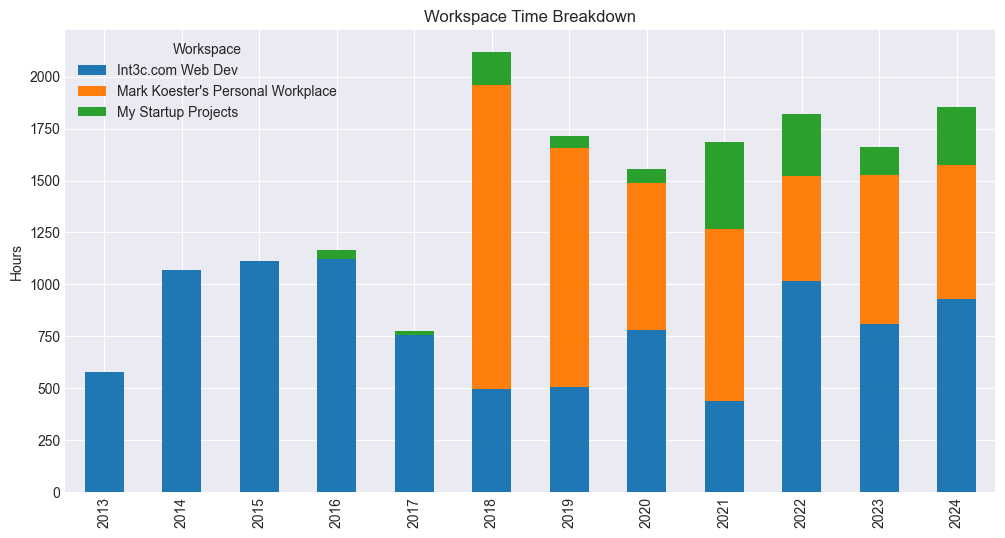
- Time allocated across my workspaces increased steadily from 2013 to a peak in 2018, after which there were fluctuations. 2024 shows a rise in total time nearing the levels of 2022, with a balanced distribution across all three areas.
- Time spent on my client work / sofware development (blue) saw early growth until 2016 but decreased in later years, stabilizing in last 3 years and representing a steady amount of professional work.
- Startup projects (Green) began to take on a percentage of my time post-2016 and have maintained a steady share of time allocation. This reflects a growing investment in entrepreneurial endeavors alongside my other work commitments.
Year-on-Year Computer Usage Breakdown: Productive vs. Distracting Time
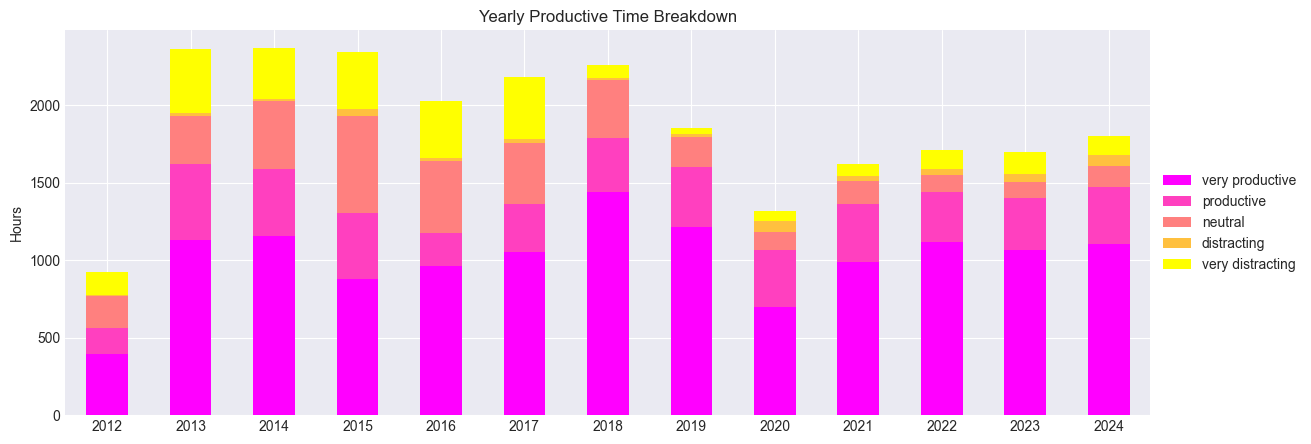
What remains to be tracked? Total Captured vs Unknown Time
While I have come to accept that a certain percentage of my time should be left untracked (largely due to the burden of manual tracking certain activities), I’ll admit that I would prefer to track as much as my time as possible.
If a single week has 168 hours, here is how much of my time is captured and known vs. what is unknown:
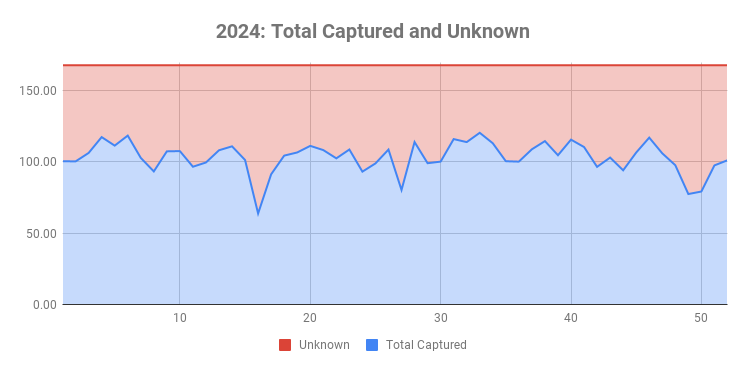
Currently, in terms of screentime, here are my two gaps:
- Kindle book reading - How much time do I spend reading per year?
- Netflix, Streatming, TV and Movie Watching - How much time do I spend watching movies or TV? Even though I don’t own a TV and don’t watch media every day, I still do my fair share of media consumption per year, and I’d love to be able to pull out a snapshot of my weekly Netflix time.
I would also love to better track and now how much time I spend on:
- All bodily movement activities including walking
- Transportation including by car, airplane or even boat.
- Cleaning & Housework
- Cooking & Eating
- Socializing
I believe some of this might be pulled from Oura or Apple Watch, especially with increasingly more accurate automatic activity detection.
I would love to know how much time I spent with others and socializing. This is believed to be a big part of health and longevity. I suspect that our phones could be used as a proxy for tracking socializing. In the future, one might use some sort of device pings/handshakes, heard voices detection, logged simultaneous connection to home Wifi or something else.
Typical Days & Daily Patterns
How do I spend a typical day? What are some of my daily patterns?

Legend: Design/Comp. | Software Dev | Comm/Schedule | Business
Creative work is a cornerstone of your daily routine, and it is good to see this reflected in my data. In view of my multiple projects and goals, I generally try to compartmentalize my days with clear boundaries for certain tasks and projects. This structured approach helps me maintain focus and manage competing priorities effectively. In these the data charts I see a strong bias towards prioritizing Design/Composition and Software Development, while also ensuring time for Communication/Scheduling and Business which are also crucial for my operational, strategic and executive responsibilities.
